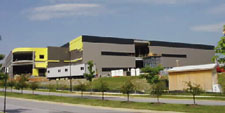 |
 |
| FINDING NANO Cranes dominate site of $175-million NIST nanoscale lab (above), while $300-million complex will give Human Genome Sciences manufacturing capacity. (Photo top courtesy of HDR Inc.; bottom courtesy of Gilbane Building Co.) |
One key area of federal R&D investment now is in nanotechnologythe emerging field of molecular and atomic level research, from one to 100 nanometers. A nanometer is one-billionth of a meter. The National Nanotechnology Initiative, launched by former President Clinton in 2000 and signed into law last year by President Bush, will fund $3.7 billion in new research through fiscal 2008. "This makes nanotechnology a long-term scientific initiative," says Mark Jamison, advanced technology manager for HDR Inc., Omaha.
Bush now wants nearly $1 billion in fiscal 2005 to spread around federal agencies and their academic partners (see chart, next page). "The investment will advance our understanding of nanoscale phenomena...and enable use of this knowledge to bring about improvements in medicine, manufacturing, high-performance materials, information technology and energy and environmental technologies," says a White House Office of Science and Technology Policy statement. The effort is already requiring exacting structures that push the envelope of design and construction technique, and require newand not always smoothrelationships between government, academic project owners and their building teams.
|
The U.S. Commerce Dept.s National Institute of Standards and Measures (NIST) last month dedicated its $175-million Advanced Measurement Laboratory in Gaithersburg, Md. "This is probably the most environmentally controlled building in the world," says Jamison, whose firm is the designer. "Mechanical and electrical systems cannot impact research. We have to do special shielding to prevent electricity running through wires from ruining experiments." Clark Construction, Bethesda, Md., is contractor with Johnson Controls, Milwaukee, the key subcontractor.
The facility and another for NIST in Boulder, Colo., were built to strict tolerances. Inside temperatures had to be controlled to within 1/100th of a degree C and vibration levels kept as low as 100 micro in. per second. "Otherwise, there would be possible electromagnetic contamination," says Jamison. "This is beyond anything weve done before." HDR is also beginning work on nanotech centers at the U.S. Energy Dept.s Sandia and Los Alamos national laboratories in New Mexico. They are among five to be built at DOE lab sites, as the agency converts from Cold War defense work to civilian technology. "Every DOE lab wants a nano center," he says.
| RELATED LINKS |
| R&D Market Is Industry�s New Testing Lab |
| Officials Look to R&D Clusters as A Development Catalyst |
Other agencies are funding new missions and construction projects, from the $45-million, national Aeronautics and Space Administration-supported Institute for Nanoelectronics and Computing at Purdue University, West Lafayette, Ind., to the planned Institute of Soldier Nanotechnologies at the Massachusetts Institute of Technology, Cambridge, Mass., that has Defense Dept. funding. CDM, also based in Cambridge, is doing a feasibility study for the MIT center, which will research ways to make military gear "lighter and stronger," says firm architect Ed Galindo.
Industry firms are gearing up for the nanotech trend. Engineer Flad & Associates, Madison, Wis., last year formed a "nanotech initiative" in its R&D practice. It borrows heavily from semiconductor design, says Michael Uyeda, senior associate, who...
ixing what ails society is generating multibillion-dollar investments in far-reaching arenas of research by the federal government and private sector. The goals are not totally altruistic, however, as agencies vie for new missions that will bolster budgets and prestige, and biotech companies push to turn expensive research into bottom-line profit.